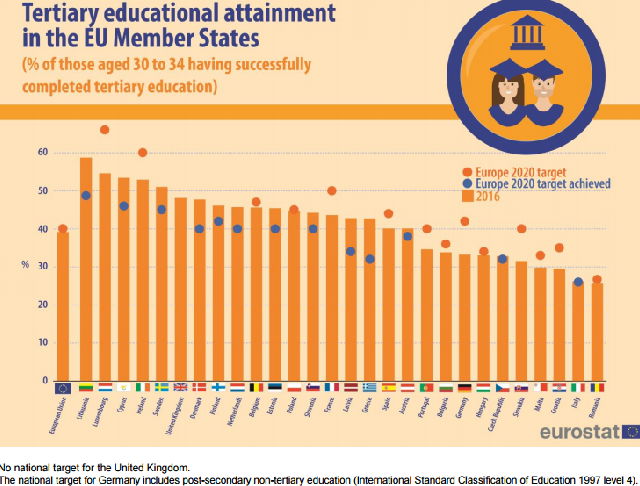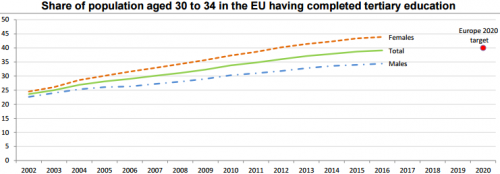 The latest Eurostat data on two education indicators reveal the Romanian education system.
The latest Eurostat data on two education indicators reveal the Romanian education system.
Romania is the EU country with the lowest rate of university graduates in the total population aged 30-34 (25.6%).
But it ranks 3rd, after Spain and Malta, in the category of 18 to 24-year-olds who graduated a maximum 10-year, according to the Eurostat data.
It is a situation that will not allow Romania to reach the EU’s competitiveness level in a near future.
If compare the number of higher education graduates to the EU average, Romania is in 2003
In Romania, the share of higher education graduates in the group of people aged between 30 and 34 is 25.6%, compared to the European average, of 39.1% in 2016.
This level positions our country the last in the EU:
 If we make the ratio between the national rate to the European average, Romania is at the level of 2003.
If we make the ratio between the national rate to the European average, Romania is at the level of 2003.
According to the Eurostat data, the EU average of university graduates in the 30-34 age group has advanced from 23.6% in 2002 to 39.1% in 2016.
 The target for 2020 is for at least 40% of the Europeans aged between 30-34 to be higher education graduates.
The target for 2020 is for at least 40% of the Europeans aged between 30-34 to be higher education graduates.
The national target for the same year is only 26.7%.
The highest rates have been registered last year in Lithuania (58.7%), Luxembourg (54.6%), Cyprus (53.4%), Ireland (52.9%) and Sweden (51.0%), the only countries scoring above 50% for the 30-34 age group.
Highest rates of young people who graduated no more than a 10-year cycle
In the group of countries with a high number of young people with low education, Romania ranks among top 3 countries, as well as among the only three countries that have not decreased these rates over the last 10 years.
Malta, Spain and Romania have the highest shares of young people aged 18-24 who graduated a 10-year cycle at the most – 19.6%, 19.0% and 18.5%, respectively.
 The lowest rates of early school leavers are in several former communist countries – Croatia (2.8%), Lithuania (4.8%), Slovenia (4.9%) and Poland (5.2%).
The lowest rates of early school leavers are in several former communist countries – Croatia (2.8%), Lithuania (4.8%), Slovenia (4.9%) and Poland (5.2%).
By this indicator, Romania’s level is similar to the EU average registered around 2000, about 17 years ago. The EU average decreased from 17.0% in 2002 to 10.7% in 2016.

It is worth noting Lithuania, which is well positioned by both indicators – with the highest rate of graduates (almost 60%), and the second lowest share of young people leaving early the education system (4.8%).
Beyond the statistical data, the education quality level in this country, compared to Romania, is also confirmed by the fact that one of the universities from Lithuania – Vilnius University – ranked last year 481-490th in “QS World University Rankings”. Three other institutions ranked in the 700+ category.
In the same ranking, the four higher education institutions in Romania – University of Bucharest, Babes – Bolyai University of Cluj, Alexandru Ioan Cuza – Iasi and Universitatea de Vest of Timisoara – all ranked in the 700+ category.
Lithuania has a population of about 3 million, and Romania almost 20 million.









